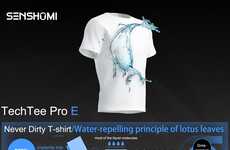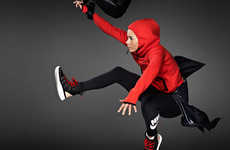
Columbia Omni-Freeze Zero Fabric Keeps You Cool
Sarah Moore — June 14, 2012 — Lifestyle
The Columbia Omni-Freeze Zero fabric makes good use of the sweat that humans naturally accumulate in an attempt to cool themselves down by turning that perspiration into an internal cooling system.
While traditional sportswear simply wicks the sweat away from one’s body to keep the icky moisture from settling into clothing, Columbia’s newest technology actually uses that sweat to imitate and enhance the body’s natural cooling process.
As sweating is the body’s natural way of lowering one’s body temperature, the designers at Columbia decided to mimic this process and use one’s own moisture to keep them cool.
Special polymer material in the fabric reacts to perspiration, rain or other moisture by swelling up, similar to the way goosebumps appear on one’s arm, to contain the cooling sensation derived from the perspiration process. There’s no mention however, of how smell-resistant these garments will be—something that could certainly pose an awkward problem.
While traditional sportswear simply wicks the sweat away from one’s body to keep the icky moisture from settling into clothing, Columbia’s newest technology actually uses that sweat to imitate and enhance the body’s natural cooling process.
As sweating is the body’s natural way of lowering one’s body temperature, the designers at Columbia decided to mimic this process and use one’s own moisture to keep them cool.
Special polymer material in the fabric reacts to perspiration, rain or other moisture by swelling up, similar to the way goosebumps appear on one’s arm, to contain the cooling sensation derived from the perspiration process. There’s no mention however, of how smell-resistant these garments will be—something that could certainly pose an awkward problem.
Trend Themes
1. Sweat-activated Cooling - Opportunity to develop clothing and materials that utilize sweat to enhance the body's natural cooling process.
2. Moisture-responsive Fabrics - Potential for developing textiles that react to moisture, such as perspiration or rain, to provide specific functionalities.
3. Body-heat Regulation - Opportunity to create fabrics or technologies that help regulate body temperature through natural processes like sweating.
Industry Implications
1. Sportswear - Sweat-activated cooling technology opens up new possibilities for sportswear manufacturers to create innovative and performance-enhancing apparel.
2. Textile Manufacturing - The development of moisture-responsive fabrics presents an opportunity for textile manufacturers to offer specialized materials for various applications.
3. Outdoor Gear - The advancement in body-heat regulation fabrics can be applied in outdoor gear industry, enabling the creation of cooling garments for outdoor activities.
3.9
Score
Popularity
Activity
Freshness























